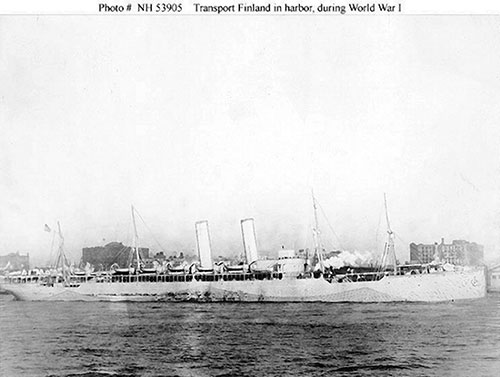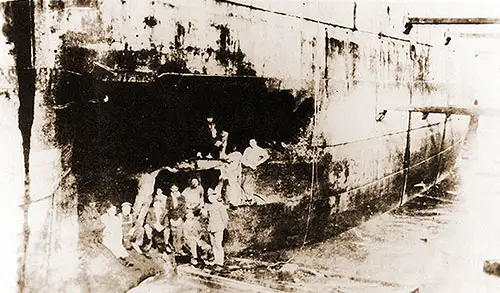Army Charted Transport Finland Struck by Torpedo - 1919

The USAT Finland, a Transport Ship During WW1, in Harbor. Chartered by the Army Transport Service 3 June 1917. Naval History & Heritage Command NH 53905 Finland (ID 4543). GGA Image ID # 17fb0cc232
Eleven days later on 28 October 1917, the Finland, an army chartered transport, was struck by a torpedo from U-93 not far from the French coast. Though the explosion blew a huge hole in the ship's side, she was successfully navigated to port, was repaired, and put back into service.
The senior naval officer on board, Captain Stephen V. Graham, in his report, gave this account of the incident:
"The weather was cloudy, and a moderate sea with white caps was running, and I was personally keeping a very careful lookout for submarines and was engaged in searching the water on both sides with powerful binoculars.
At about 9:25 A. M., I had just finished searching the water on the starboard side when the naval signal quartermaster on watch called out, 'Commander, torpedo.'
I turned and saw a torpedo about 50 to 100 yards distant, making a surface run directly toward the ship. The whirring of the torpedo's propellers could be heard when they broke the surface of the water.
The torpedo was so close to the ship when it was sighted that any maneuver to avoid it was entirely impossible.
I sprang toward the engine telegraph to give the signal for stopping the engines, but before I could do this, the torpedo exploded directly under the bridge.
The concussive effect of the explosion was considerable but not as great as had been anticipated. No 'one on the bridge was injured by it.
This is undoubtedly due to the fact that the enemy economized in the explosive charge of torpedoes destined for use against merchant's vessels and used only enough to produce the desired rupture in a vessel's skin plating.
"Notwithstanding the fact that the torpedo was only 4 or 5 feet below the surface when it exploded against the ship's side, an immense volume of water was thrown up.
The engines were promptly stopped, and the whistle signal made to indicate to the other vessels present that the ship had been torpedoed. It is a curious fact that most of the other vessels present did not know that the Finland had been torpedoed until this signal was made.
Ship Righted Herself After Blow
"I directed a radio operator to send out an S. O. S. call, but it was found that the aerial had been carried away by the force of the explosion. The first report that reached the bridge was that the forward fireroom was flooded. At this time, it did not appear probable that the ship would sink, but in a short time, she began to list heavily to starboard and seemed to be settling.
I ordered the lowering of the remaining boats hanging on their falls at the promenade deck level. These boats were scarcely in the water when the ship began to right herself, and the acting master, Chief Officer John Jensen, who had been below to investigate the extent of the damage, returned to the bridge and reported to me that the damage had been confined to No. 4 hold, the bulkheads of which were intact.
"In the meantime, I observed Third Assistant Engineer George Mikkelsen, who had been on watch in the engine room when the torpedo struck the ship, moving about the main deck with a wooden mallet in his hand endeavoring to drive terrified firemen back to their stations. He came to the bridge and reported to me that the boilers and engines were not damaged and that the ship could be got underway again in a short time if he could get the men back to their stations.
"The compartment in which the damage had been done was hold No. 4, situated immediately forward of the firerooms and used as a reserve coal bunker. At the time the ship was torpedoed, this hold contained about 600 tons of coal. After the ship had been placed in dry dock upon her return to France, it was found that most of this coal had run out through the hole made in the ship's side by the explosion of the torpedo.

Workers Pose by the Torpedo Damage to Finland in Drydock at Brest, France. SS Finland (American Passenger Steamship, 1902) in Drydock at Brest, France, Showing Damage Received When She Was Torpedoed on 28 October 1917. This Ship Was USS Finland (ID # 4543) in 1918-1919. Courtesy of Captain John P. Cummings, USNR (Dental Corps), Retired. Naval History & Heritage Command NH 53906. GGA Image ID # 17fb3fc6f8
Heavy Squall Hampered Rescue Work
"When I received the master's report that the damage was confined to this one compartment, I hailed the boats which were close to the ship and directed them to come alongside and had a signal sent to the escorting yachts to send back to the Finland boats which were approaching them.
These yachts, the Alcedo and Wakiva, had come close to the Finland and lowered boats to rescue people who had been cast into the water by the dropping of the two boats mentioned above. The converted yacht Corsair and one of the destroyers were circling at high speed around the Finland and dropping depth charges in order to prevent the enemy submarine from delivering a second attack on the crippled Finland.
"While the Finland's boats were in the water a heavy squall came up and rendered the return of the heavily laden boats very difficult. They could come alongside only on the starboard side, and getting the people back on board was very slow work.
Hoisting the boats was not to be thought of, for every moment that this large ship remained stopped was attended with grave danger of receiving a second torpedo. As soon as the passengers were out of the boats, the latter were cast adrift. The ship got underway to return to a French port 150 miles distant.
The Finland was escorted into port by the Corsair and one of the destroyers under the command of Commander F. N. Freeman. One destroyer remained with the Alcedo and Wakiva to afford them protection while they were picking up the remainder of the Finland's crew.
The other two destroyers had proceeded with the two freighters, which steamed away at full power from the scene of the torpedoing of the Finland.
"During the return of the ship to the French port, it became necessary to send everyone to the fireroom who could shovel coal. Deckhands, stewards, and even passengers, including some of the discharged American ambulance drivers, responded with alacrity to this call, and within a short time after starting ahead, the ship was making nearly 15 knots, which was as good a speed as she had made at any time during her employment in the transport service.
"The bulkheads of the damaged compartment held, and there was no leakage of water through the water-tight doors leading into the forward fireroom and the adjacent hold. The doors were kept closed tightly with wooden wedges.
Youngest Officer Stayed by His Gun
"On the way into port, the nervous tension of those on deck was greatly relieved by the necessity of laughing at the earnestness with which several lookouts reported a spouting whale as a submarine.
It is regrettable that eight men lost their lives on the occasion of the torpedoing of the Finland. The coolness and resourcefulness of the acting master and engineer of the watch are deserving of commendation.
Cadet Officer David McLaren was the youngest officer on board—just 18 years old. After I had ordered the lowering of the boats, this lad, who was in charge of one of them and would have been entirely justified in leaving the ship which he believed to be sinking, returned to the bridge and reported to me that his boat was lowered and clear of the ship and asked if he could be of any service.
He remained on the bridge, rendering valuable assistance and displaying nerve and resourcefulness worthy of the sea's best traditions. One naval lad was down in the living compartment cleaning up when the ship was struck.
Someone in one of the boats hanging at the davits seeing him hurrying along the promenade deck, asked him which boat he belonged to. He replied, 'Boat No. 4.'
The inquirer said, 'This is No. 4; jump in.' And the youngster replied, 'Oh, no, I have to go to my gun.' And he did.
"The following-named naval officers were assigned to the Finland: Captain Stephen V. Graham, United States Navy; Lieutenant Clarkson J. Bright, United States Navy; Ensign William J. Forrestel, United States Navy.
"A large number of survivors from the transport Antilles, which about io days previously had been torpedoed and sunk in four or five minutes, were on board the Finland when she was torpedoed.
"A great many pieces of the torpedo which struck the Finland fell on deck and were collected and carefully guarded by the crew and passengers.
"One lad claimed that he had a piece which bore the name of the maker of the torpedo. When he produced it, it was one of the vertical rudders that bore the inscription `Rechts' (German for `right').
"The submarine which fired the torpedo into the Finland was seen neither before nor after it was fired. When the Finland was placed in dry dock at the French port it was found that the torpedo had made a hole in the ship's side about 35 feet in a horizontal direction near the waterline and extending down to the bilge-keel in an irregular V shape.
"The compartment was completely gutted, and a period of two months was required to effect the necessary repairs."
Ship's History
- Laid down in 1902 by William Cramp and Sons, Philadelphia, PA
- Launched in 1902 for the International Mercantile Marine Co.
- Chartered by the Army Transport Service 3 June 1917
- Designated ID-4543 in late 1917
- Delivered to the Navy 24 April 1918
- Commissioned USS Finland 26 April 1918
- Decommissioned 15 November 1919 and transferred to the War Department for later return to the Red Star Line. Awarded World War I Victory Medal (with Armed Guard and Transport clasps)
- Chartered by the American Line in 1923
- Scrapped in 1928 by Hughes Bolckow Shipbreaking Ltd at Blyth, Northumberland, England
Ship's Specifications
- Displacement: 22,400 t.(fl)
- Length: 580'
- Beam: 60' 2"
- Draft: 31' 4"
- Speed: 15.7 kts.
- Complement: 414
- Armament: Four 4"/40 gun mounts, two 1-pounders and two machine guns
- Propulsion: Nine single ended and one auxiliary boiler, two 4,650hp vertical triple-expansion steam engines, two shafts
John Wilber Jenkins, "Army Charted Transport Finland Struck by Torpedo," in Our Navy's Part in the Great War, New York: John H. Eggers Company, Inc., 1919, pp. 16-19. Ship History and Specifications Courtesy of Naval History & Heritage Command.
